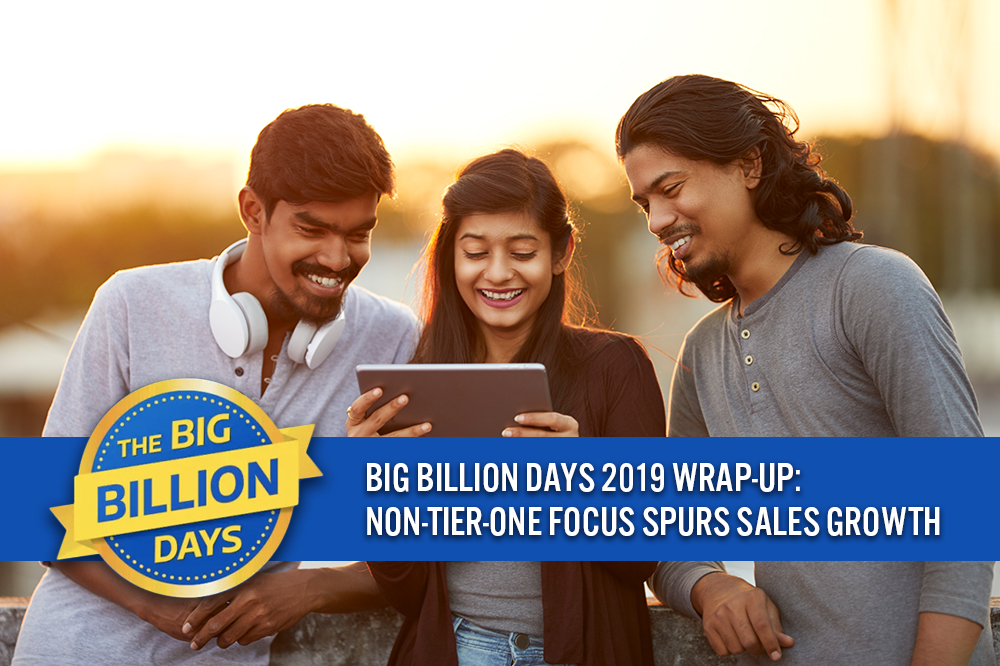
Nitheesh NH
We have more than doubled our transaction units—customers from tier-two/ three cities—which was the biggest focus for us. We believe we are closing the six days [of sales] with 70–75% of the festive market share. New customer growth is 50–60%.
Whether it is the uptake of the Hindi interface or the adoption of our affordability constructs [and] engagement constructs like gaming, consumers have engaged with brands they love like never before.
Key Highlights of BBD 2019 Following are some of the key statistics from BBD 2019 as announced by Flipkart:
- 70 billion views over the six-day sale period.
- New customers grew by 50%.
- Over 50% of Flipkart Plus shoppers were based in non-tier-one cities and towns.
- More than 50% growth in the number of participating sellers compared to BBD 2018.
- Sales generated from tier-three cities and towns grew by 100% year over year.
- Almost half of the top sellers on Flipkart registered three times the sales they saw last year.
- More than 40% of sellers during the sale were based in non-tier-one cities and towns.
- Close to 50% growth in the number of new seller cities.
- Number of transactions via financing options like equated monthly installments, Flipkart Pay Later and Cardless Credit grew by 70% compared to BBD 2018.
- Artists and weavers who participated in the festival through the “Flipkart Samarth” initiative experienced more than 100% sales growth during the six-day event. (Flipkart Samarth seeks to offer national market access to local artisan and handicraft communities.)
 Source: Flipkart[/caption]
Amazon’s Great Indian Festival Also Posts Highest-Ever Sales
Amazon’s Great Indian Festival (GIF) 2019, which ran in parallel with BBD 2019, also brought down the curtains on its six-day festive season sale on October 4.
The company stated that this was its biggest festive season sales in India ever, and a significant portion of new customer growth came from non-tier-one cities and towns. According to the company, it received orders from 99.4% of pin codes (postal codes), while more than 65,000 sellers received orders from over 500 cities across the duration of the sale period.
Amazon stated that “availability of selection, convenience and affordability” was a significant factor that enabled it to record its highest-ever sales.
[caption id="attachment_97777" align="aligncenter" width="700"]
Source: Flipkart[/caption]
Amazon’s Great Indian Festival Also Posts Highest-Ever Sales
Amazon’s Great Indian Festival (GIF) 2019, which ran in parallel with BBD 2019, also brought down the curtains on its six-day festive season sale on October 4.
The company stated that this was its biggest festive season sales in India ever, and a significant portion of new customer growth came from non-tier-one cities and towns. According to the company, it received orders from 99.4% of pin codes (postal codes), while more than 65,000 sellers received orders from over 500 cities across the duration of the sale period.
Amazon stated that “availability of selection, convenience and affordability” was a significant factor that enabled it to record its highest-ever sales.
[caption id="attachment_97777" align="aligncenter" width="700"] Source: Amazon[/caption]
GIF 2019: Key Highlights
Source: Amazon[/caption]
GIF 2019: Key Highlights
- Smartphones: Grew 15-fold, with brands like Samsung, OnePlus, Apple, Xiaomi and Vivo leading the way.
- Fashion: Grew five-fold, with shoes registering a “6X growth” while apparel registered “4X growth.”
- Large appliances: Grew “8X,” with almost 50% of sales generated from non-tier-one cities and towns.
- Echo devices: Grew 70-fold in the “best-ever” sale for Amazon devices in India.
- New customer growth: Around 88% of new customers were from small towns.
The first wave of the Great Indian Festival was our biggest celebration ever, with Amazon.in witnessing the highest share of transacting customers and purchases across all marketplaces in India; orders from 99.4% pin codes (postal codes); over 65,000 sellers from 500+ cities receiving orders in just five days; and customers from over 15,000 pin codes joining Prime.
Key Insights Both Flipkart and Amazon announced record-high sales in their respective festive season sales in 2019, driven by significant growth in non-tier-one cities and towns. In the absence of comparable data, it is not clear as to which retailer generated the lion’s share of sales. However, the success of the strategy to focus on smaller towns and cities to drive sales growth implies that the battleground has shifted. Festive season sales in India’s e-commerce landscape will continue to grow year on year, as mobile and internet penetration deepens and online shopping becomes more popular. The battle for supremacy between the country’s two major e-commerce companies is therefore set to intensify.